|
MOD - Creating a star 0.980
|
|
| Zefnoly | Date: Wednesday, 17.02.2016, 10:57 | Message # 46 |
 Space Tourist
Group: Users
 Pirate
Pirate
Messages: 38
Status: Offline
| Ehm... Your basic script? the cordinates you make the new star with? it wouldn't be the same as our real solar system? I used it to make a test star and, well... Earth cannot be found along all our other planets when i press (go to) when i select them in search bar. Noticed the new star i made is located where it seems our real solar system used to be. Is it gone forever or will it reappear when i move the new star i made? And is there any guides to help you pin down cordinates for where you want to make the star?
A creature from a planet found far on the other side of Milkyway, found on a planet orbiting a gas giant.

|
| |
| |
| JackDole | Date: Wednesday, 17.02.2016, 11:03 | Message # 47 |
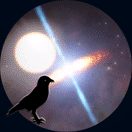 Star Engineer
Group: Local Moderators
 Germany
Germany
Messages: 1742
Status: Offline
| Zefnoly,
if you have made a script, and then the earth is gone, then you might have forgotten a bracket in your script. Can you post the script here?
Don't forget to look here.

|
| |
| |
| Zefnoly | Date: Wednesday, 17.02.2016, 11:14 | Message # 48 |
 Space Tourist
Group: Users
 Pirate
Pirate
Messages: 38
Status: Offline
| JackDole,
Here is the script
Code // Create a new object - star "Zenda"
Star "Zenda"
{
RA 16 10 45 // Right ascension
Dec -25 12 11 // Declination
Dist 100.0 // Distance from the Sun
Class "B" // Spectral class
Lum 1 // Luminosity, or
//AbsMagn 5.31 // absolute magnitude, or
//AppMagn 10.31 // visual magnitude
NoPlanets false // disable generation of procedural planetary system
}
Also... Is it a way to get coordinates from your camera location while in SE and then use them here to create the star? Or would it just be easier to locate a star at the location that is all ready generated there and then export it for editing?
A creature from a planet found far on the other side of Milkyway, found on a planet orbiting a gas giant.

|
| |
| |
| Zefnoly | Date: Wednesday, 17.02.2016, 11:30 | Message # 49 |
 Space Tourist
Group: Users
 Pirate
Pirate
Messages: 38
Status: Offline
| I removed the new star i made but earth is stil gone? how can i fix this? Is my installation broken because of the new star i made?
EDIT:
Here is what happends when i try to search for planets in our system and then ask it to go there. Just getting "planet not found"
I used OP's script. Only change i did to it was the name just to see if i could make a new star. Now our system is completely gone. Strange the search thing has it but cant find it's location.

A creature from a planet found far on the other side of Milkyway, found on a planet orbiting a gas giant.

Edited by Zefnoly - Wednesday, 17.02.2016, 11:36 |
| |
| |
| JackDole | Date: Wednesday, 17.02.2016, 11:53 | Message # 50 |
 Star Engineer
Group: Local Moderators
 Germany
Germany
Messages: 1742
Status: Offline
| Zefnoly,
have you made any changes to the 'universe.cfg'? Maybe you made a mistake. Try to undo the changes.
Or on the original 'star.sc' file? Restore the original state.
Or at the pak file? Never change anything at the original pak files.
At your star everything is okay.
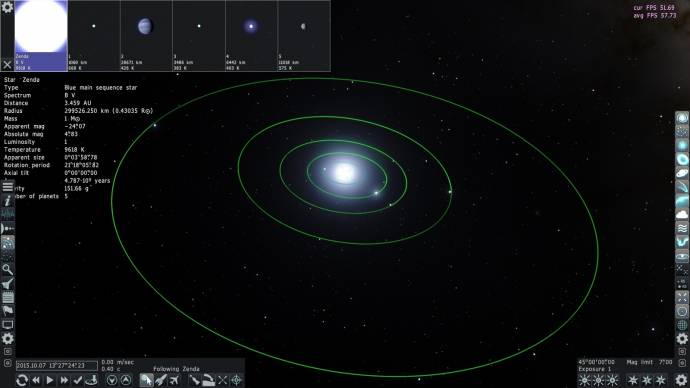
Don't forget to look here.

Edited by JackDole - Wednesday, 17.02.2016, 12:03 |
| |
| |
| Zefnoly | Date: Wednesday, 17.02.2016, 12:03 | Message # 51 |
 Space Tourist
Group: Users
 Pirate
Pirate
Messages: 38
Status: Offline
| JackDole, No i didn't change anything in universe.cfg as i remember. I looked at it only. Then i made the folder "stars" in catalogs.
I placed the script in the "stars" folder and named the script "Stars.sc" in Notepad++ with the code i sent up ahead. The code is copy paste from the tutorial on the beginning of the thread. I have not even touched the pak files. I only made the script inside the "stars" folder.
Edit:
We are talking about the issue where Earth and all our other planets in our real system just disappeared completely after i made the star. Yes the star works fine but i didn't want to remove Earth.
Also I'm using version 0.974 path 08
A creature from a planet found far on the other side of Milkyway, found on a planet orbiting a gas giant.

Edited by Zefnoly - Wednesday, 17.02.2016, 12:10 |
| |
| |
| JackDole | Date: Wednesday, 17.02.2016, 12:17 | Message # 52 |
 Star Engineer
Group: Local Moderators
 Germany
Germany
Messages: 1742
Status: Offline
| Zefnoly,
the name of the original file for stars in .pak archives is 'stars.sc'.
You can not use this name for your scripts.
Name your script 'Zenda.sc'.
Then add in the 'unverse.cfg' in the in the section:
'StarsCatalogs // stars catalogs' the line:
Code "catalogs/stars/Zenda.sc"
Don't forget to look here.

|
| |
| |
| Zefnoly | Date: Wednesday, 17.02.2016, 12:24 | Message # 53 |
 Space Tourist
Group: Users
 Pirate
Pirate
Messages: 38
Status: Offline
| JackDole, Ah... See where i did wrong. But do i stil need to reinstall to fix it or just rename the file i made?
EDIT:
Solved
A creature from a planet found far on the other side of Milkyway, found on a planet orbiting a gas giant.

Edited by Zefnoly - Wednesday, 17.02.2016, 12:24 |
| |
| |
| JackDole | Date: Wednesday, 17.02.2016, 12:32 | Message # 54 |
 Star Engineer
Group: Local Moderators
 Germany
Germany
Messages: 1742
Status: Offline
| Zefnoly,
In the 'stars.sc' file is also our sun. Once you've made a script with this name - and SpaceEngine always uses the latest file by that name - have you virtually 'killed' our sun. The planets are in the 'SolarSys.sc' file. Therefore, they still appear in the browser, but can no longer be selected.
How to find coordinates for a self made system:
Go to the position where you want your system.
Select a nearby star. As close as possible.
Open with 'F2' the system browser'.
Go to the earth, but let the system browser open.
Select the star in the system browser with a 'right-click'.
Open the info window (Wiki).
In the tab 'General' you can find this information:
Distance = Dist
Right Ascension = RA
Declination = Dec
Write down these values and use them for your system.
Change it a little in the minutes or seconds; so your star does not sit in exactly the same position as this star.
The further away is the star of the earth, the smaller have to be changes.
Try around a bit.
To my knowledge, there is no more accurate method.
Don't forget to look here.

|
| |
| |
| Zefnoly | Date: Wednesday, 17.02.2016, 13:25 | Message # 55 |
 Space Tourist
Group: Users
 Pirate
Pirate
Messages: 38
Status: Offline
| Another Question:
Is it possible to find/locate a system and then export it. Then add it in the catalog/stars folder with name ex: Zenda and then edit that? I thought it would be easier to just export a system i find and then just edit it. Like edit the planets etc. in the file. I want to make a planet with life orbiting a gas giant so i located a nice system i found (procedural generated) and exported it like i told here. I replaced the Zenda file because i want this to be the system i made.
Then i found a temperate moon around one of the gass giants. I exported another planet i found with life that has the terrain i want on it. I copied the surface information along the atmosphere information and placed them correctly (replaced the previous settings on the code of the moon) and some other stuff to turn it into a terra. But no changes happends in Space Engine? Not sure what i have done wrong but i can post the part of the system code regarding this planet.
Code Planet "Zevila"
{
ParentBody "2"
Class "Terra"
Mass 1.1
Radius 6250
InertiaMoment 0.327901
Oblateness 0.00335
RotationPeriod 23.9345
RotationOffset -79.5
Obliquity 23.4393
EqAscendNode 180
Precession 25592
AlbedoBond 0.306
AlbedoGeom 0.367
Brightness 1.4
Color (0.538 0.581 0.661)
Life
{
Class "Organic"
Type "Multicellular"
Biome "Marine/Terrestrial"
}
Surface
{
TidalLocked false
SurfStyle 0.451697
OceanStyle 0.768877
Randomize (0.019, 0.744, -0.455)
colorDistMagn 0.0565345
colorDistFreq 808.698
detailScale 16623
colorConversion true
seaLevel 0.533066
snowLevel 2
tropicLatitude 8.74228e-08
icecapLatitude 0.607092
icecapHeight 0.555758
climatePole 0.9375
climateTropic 0.3125
climateEquator 0.6875
heightTempGrad 0.625
tropicWidth 0.07
mainFreq 0.888327
venusFreq 1.13636
venusMagn 0
mareFreq 5.33561
mareDensity 0.0664987
terraceProb 0.162816
erosion 0.122947
montesMagn 0.187785
montesFreq 317.939
montesSpiky 0.978946
montesFraction 0.358803
dunesMagn 0.0441079
dunesFreq 58.1845
dunesFraction 0.223739
hillsMagn 0.12984
hillsFreq 710.729
hillsFraction 0.398205
hills2Fraction 0.245728
riversMagn 67.8226
riversFreq 3.10514
riversSin 6.26867
riversOctaves 2
canyonsMagn 0.0167692
canyonsFreq 187.624
canyonFraction 0.389672
cracksMagn 0.0625292
cracksFreq 0.618189
cracksOctaves 0
craterMagn 0.556678
craterFreq 19.7145
craterDensity 0
craterOctaves 0
volcanoMagn 0.757208
volcanoFreq 1.36613
volcanoDensity 0.4
volcanoOctaves 1
volcanoActivity 1.53286
volcanoFlows 0.694553
volcanoRadius 0.217831
volcanoTemp 1667.96
lavaCoverTidal 0
lavaCoverSun 0
lavaCoverYoung 0
twistZones 1
twistMagn 3.5
cycloneMagn 1.09711
cycloneDensity 0.389527
colorSea (0.040, 0.200, 0.200, 1.000)
colorShelf (0.150, 0.370, 0.370, 1.000)
colorBeach (0.400, 0.330, 0.280, 0.000)
colorDesert (0.260, 0.240, 0.220, 0.000)
colorLowland (0.500, 0.420, 0.350, 0.000)
colorUpland (0.240, 0.210, 0.210, 0.000)
colorRock (0.220, 0.210, 0.210, 0.000)
colorSnow (1.000, 1.000, 1.000, 1.308)
colorLowPlants (0.010, 0.010, 0.010, 0.000)
colorUpPlants (0.020, 0.030, 0.080, 0.000)
BumpHeight 18.8268
BumpOffset 10.0359
DiffMapAlpha "Water"
SpecBrightWater 0.65
SpecBrightIce 0.85
SpecularPower 55
Hapke 0
SpotBright 4
SpotWidth 0.05
DayAmbient 0.07
}
Clouds
{
TidalLocked false
Height 2.65967
BumpHeight 5.86016
Hapke 0.2
SpotBright 2
SpotWidth 0.15
DayAmbient 2
mainFreq 0.97475
mainOctaves 10
Coverage 0.193478
twistZones 1
twistMagn 3.5
}
Clouds
{
TidalLocked false
Height 5.31934
BumpHeight 6.74079
Hapke 0.2
SpotBright 2
SpotWidth 0.15
DayAmbient 2
mainFreq 0.97475
mainOctaves 10
Coverage 0.193478
twistZones 1
twistMagn 3.5
}
Clouds
{
TidalLocked false
Height 7.979
BumpHeight 6.69462
Hapke 0.2
SpotBright 2
SpotWidth 0.15
DayAmbient 2
mainFreq 0.97475
mainOctaves 10
Coverage 0.193478
twistZones 1
twistMagn 3.5
}
Ocean
{
Height 10.0359
Hapke 0
SpotBright 2
SpotWidth 0.15
DayAmbient 2
}
NoLava true
Atmosphere
{
Model "Earth"
Height 38.4966
Density 0.154872
Pressure 0.133164
Bright 10.9143
Opacity 1
SkyLight 3.63809
}
Aurora
{
Height 113.609
NorthLat 76.6058
NorthLon -136.489
NorthRadius 1696.84
NorthWidth 1740.47
NorthRings 3
NorthBright 0.3
NorthParticles 50000
SouthLat -69.5525
SouthLon 31.9286
SouthRadius 1658.16
SouthWidth 1974.12
SouthRings 2
SouthBright 0.3
SouthParticles 50000
TopColor (1.000 1.000 1.000)
BottomColor (0.000 1.000 0.000)
}
NoRings true
NoAccretionDisk true
NoCometTail true
Orbit
{
RefPlane "Equator"
SemiMajorAxis 0.0020602
Period 0.0024938
Eccentricity 0.0137962
Inclination -0.994547
AscendingNode 4.3043
ArgOfPericenter -8.89918
MeanAnomaly -26.5116
}
}
This is from a complete system code regarding the system. I edited one of the moons on the gas giant in it. That code is copy pasted from the moon i edited. I combined it with information from earth and that other planet to make it into the planet i wanted.
When i launch SE no changes is done to the system. I don't know why. How am i supposed to edit a system if possible since this code doesn't change anything to it? I have included the address to the code in universe.cfg like told earlier.
A creature from a planet found far on the other side of Milkyway, found on a planet orbiting a gas giant.

|
| |
| |
| Zefnoly | Date: Wednesday, 17.02.2016, 14:20 | Message # 56 |
 Space Tourist
Group: Users
 Pirate
Pirate
Messages: 38
Status: Offline
| Quote JackDole (  ) How to find coordinates for a self made system:
Go to the position where you want your system.
Select a nearby star. As close as possible.
Open with 'F2' the system browser'.
Go to the earth, but let the system browser open.
Select the star in the system browser with a 'right-click'.
Open the info window (Wiki).
In the tab 'General' you can find this information:
Distance = Dist
Right Ascension = RA
Declination = Dec
Hmm... Did this and cant find Right Ascension and Declination in the general tab of the distant star while on earth. Could it be Longitude and Latitude? If so which one of them is Right Ascension and Declination? And the Dist value? Is it in light years in the script? That is what i get in the general infotab in Distance
A creature from a planet found far on the other side of Milkyway, found on a planet orbiting a gas giant.

|
| |
| |
| JackDole | Date: Wednesday, 17.02.2016, 14:34 | Message # 57 |
 Star Engineer
Group: Local Moderators
 Germany
Germany
Messages: 1742
Status: Offline
| Zefnoly,
You have to click the star with the right mouse button.
RIGHT
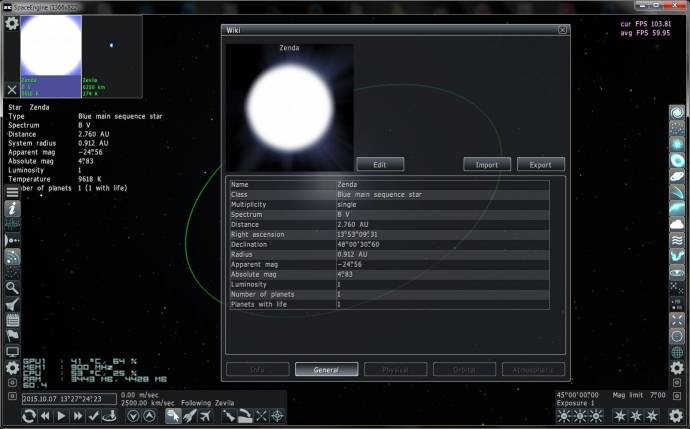
LEFT
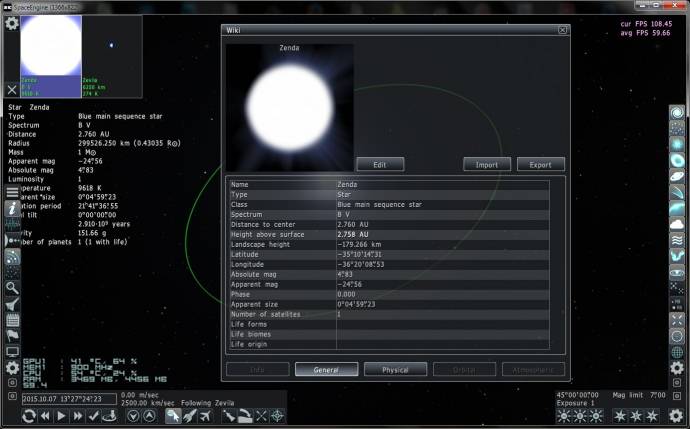
For your planetary system you need an own script. I call it 'ZendaSys.sc'.
It belongs in a folder 'catalogs\planets'
Then add in the 'universe.cfg' in the section:
'PlanetsCatalogs // planets catalogs'
the line:
Code "catalogs/planets/ZendaSys.sc"
Then you have to insert the name of your star in your script for 'ParentBody':
And 'SemiMajorAxis' must be a little larger. This is the distance of the planet to the star in astronomical units.
(I have set 1.0, the distance of the Earth to the sun.)
And remember, if you make your own planets around a star; will SpaceEngine no more create random planets.
It is possible a system to exportierne and to adapt. But that's a lot of work.
Don't forget to look here.

|
| |
| |
| Zefnoly | Date: Wednesday, 17.02.2016, 15:08 | Message # 58 |
 Space Tourist
Group: Users
 Pirate
Pirate
Messages: 38
Status: Offline
| I managed to make a new star now with the location i want but not sure what you mean with the planet thing.
Ok i made a new file located in planets catalog folder. Called it ZendaSys.sc and also made sure it is addressed in the universe.cfg.
I made a script for a Gas giant with help of exporting another gas giant i found. made sure parent body was "Zenda" as it is going to orbit that star i made. I changed the mass and size a tiny amount to just have it a little different so there is not 2 completely like gas giant in the universe (immersive vise). When i restart SE the gas giant i made a script for refuse to spawn. The procedural planets stays but not the new planet i made a script for.
Can you please tell me what i did wrong in the ZendaSys script?
Code
Planet "Meverys"
{
ParentBody "Zenda"
Class "GasGiant"
Mass 79.6977
Radius 58897.8
InertiaMoment 0.210749
Oblateness 0.0780168
RotationPeriod 12.6032
Obliquity -14.5749
EqAscendNode 155.483
AlbedoBond 0.506662
AlbedoGeom 0.607995
Brightness 2
Color (0.290 0.372 0.757)
Surface
{
SurfStyle 0.2157
Randomize (-0.425, -0.972, 0.440)
detailScale 151746
colorConversion true
tropicLatitude 0.291544
icecapLatitude 1
mainFreq 0.0281364
venusFreq 8.43772
venusMagn 0.151659
craterOctaves 0
volcanoActivity 0
lavaCoverTidal 0
lavaCoverSun 0
lavaCoverYoung 0
twistZones 7.59688
twistMagn 1.02708
cycloneMagn 11.2835
cycloneFreq 0.447179
cycloneDensity 0.15323
cycloneOctaves 2
colorLayer0 (0.810, 0.810, 0.810, 1.100)
colorLayer1 (0.630, 0.650, 0.650, 0.800)
colorLayer2 (0.580, 0.560, 0.580, 0.200)
colorLayer3 (0.610, 0.610, 0.630, 0.050)
colorLayer4 (0.720, 0.720, 0.720, 0.000)
colorLayer5 (0.780, 0.780, 0.780, 0.000)
colorLayer6 (0.540, 0.540, 0.560, 0.000)
colorLayer7 (0.690, 0.660, 0.620, 1.000)
colorLowPlants (0.720, 0.720, 0.720, 0.000)
colorUpPlants (0.780, 0.780, 0.780, 0.000)
BumpHeight 20
SpecularPower 55
Hapke 0
SpotBright 4
SpotWidth 0.05
DayAmbient 1
}
Clouds
{
Height 133.996
BumpHeight 66.1628
Hapke 0
SpotBright 2
SpotWidth 0.15
DayAmbient 1
mainFreq 1.02765
mainOctaves 10
Coverage 0.566621
twistZones 7.59688
twistMagn 1.02708
}
NoOcean true
NoLava true
Atmosphere
{
Model "Neptune"
Height 589.978
Density 4130.13
Pressure 770245
Bright 10
Opacity 1
SkyLight 3.33333
}
Aurora
{
Height 2239.26
NorthLat 85.8728
NorthLon 78.4764
NorthRadius 20444.3
NorthWidth 10882.3
NorthRings 3
NorthBright 1
NorthParticles 10000
SouthLat -85.0134
SouthLon 261.857
SouthRadius 16926.1
SouthWidth 6585.54
SouthRings 2
SouthBright 1
SouthParticles 10000
TopColor (1.000 1.000 1.000)
BottomColor (1.000 0.000 0.500)
}
NoRings true
NoAccretionDisk true
NoCometTail true
Orbit
{
RefPlane "Equator"
SemiMajorAxis 4.34271
Period 4.66265
Eccentricity 0.0598082
Inclination 2.37544
AscendingNode 162.026
ArgOfPericenter 311.894
MeanAnomaly 42.6289
}
}
I'm just not really sure how to do it yet. I understand some of it but not how i should setup the planets...
A creature from a planet found far on the other side of Milkyway, found on a planet orbiting a gas giant.

|
| |
| |
| JackDole | Date: Wednesday, 17.02.2016, 15:43 | Message # 59 |
 Star Engineer
Group: Local Moderators
 Germany
Germany
Messages: 1742
Status: Offline
| For me it works. I have done your two planets together.
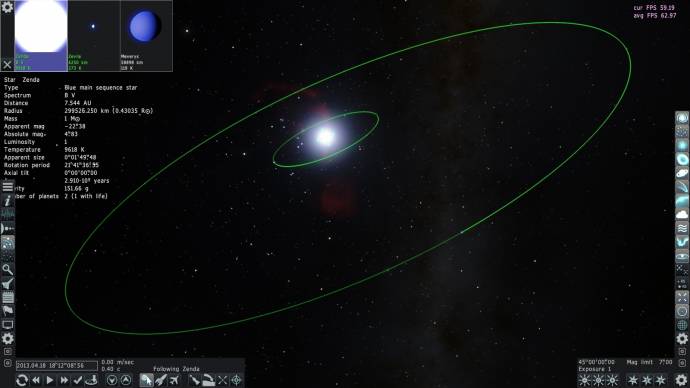
So again.
For any system that you are creating, you need at least two scripts.
A script for the 'Star', or if you want a multiple solar system, the 'StarBarycenter'.
In this script are only 'Stars' or 'StarBarycenter'.
No planets.
This script belongs in 'catalogs\stars'
And a script for the planetary system. In this script are the planets.
In a multiple star system also the stars.
This script belongs in 'catalogs\planets'.
If you do that so it must be working.
I have attached the 'ZendaSys.sc' script.
Don't forget to look here.

|
| |
| |
| Zefnoly | Date: Wednesday, 17.02.2016, 15:55 | Message # 60 |
 Space Tourist
Group: Users
 Pirate
Pirate
Messages: 38
Status: Offline
| Quote JackDole (  ) So again.
For any system that you are creating, you need at least two scripts.
A script for the 'Star', or if you want a multiple solar system, the 'StarBarycenter'.
In this script are only 'Stars' or 'StarBarycenter'.
No planets.
This script belongs in 'catalogs\stars'
And a script for the planetary system. In this script are the planets.
In a multiple star system also the stars.
This script belongs in 'catalogs\planets'.
That is what i did. I made Zenda a own script only for the star placed in the "stars" folder in catalog.
Then i made a script for the planets in "planets" folder in catalog with the gas giant script as showed above named Meverys.
But it refuses to spawn here and i have done exactly what you said.
Is it because im missing this in the script?
// ZendaSys.sc
// Autor: Zefnoly
A creature from a planet found far on the other side of Milkyway, found on a planet orbiting a gas giant.

|
| |
| |